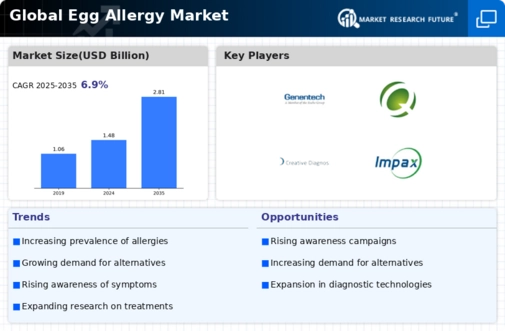Major drivers of the market
The egg allergy market size is evolving at a faster pace, and in the upcoming times, it will grow immensely. The number of cases of egg allergies is increasing day by day, both in adults as well as infants. Most number of cases over the years has happened to children more than egg allergy in adults. Symptoms of egg allergy in children outgrow way before it results in egg allergy symptoms in adults. The food allergy prevalence has increased to a greater extent which acts as a driving force for the growth of the global egg allergy market.
Several technological advancements in egg allergy medication and treatment resulted in propelling the egg allergy market size.
The technological advancements in egg allergy treatment and diagnosis methods include skin prick test, food challenge, blood test, oral immunotherapy, and many more. These advanced methods of treatment increase the skin allergy test market size and help to propagate the growth of the egg allergy market to the optimum level in the forecast period.
Significant growth opportunities for the market
The egg allergy market is increasing to greater heights in a short time span, and the market will continue to grow in the future due to an extreme increase in egg allergy cases. The skin allergy test market size is rising exponentially with the advanced technological methods of diagnosis and treatment. These advancements are not just limited to egg allergy treatment but also include advancements in the identification process and screening. Various food scanners, apps, portable devices, and wearable are helpful in determining different food ingredients related to egg allergy.
These devices are major opportunities for increasing the egg allergy industry size in the upcoming years.
Market restraints
The global egg allergy market is definitely growing at a faster rate, but the market growth can be hindered due to a lack of awareness among patients. The developing countries tend to avoid allergies, and the reason behind it lacks awareness. Many patients overlook the allergies and do not take any egg allergy treatment on time. The egg allergy cases in these countries are comparatively low, and the poor healthcare sector is also responsible for the same. Another prime restraint for the egg allergy industry is the hefty cost involved in the diagnosis and treatment process.
Many tests are also not covered by any insurance policies. Such constraints restrict the growth of the egg allergy market size.
Market Growth Challenges
The egg allergy market is immensely dependent on the number of cases of egg allergy patients. Many patients overlook and avoid egg allergy medication in time which leads to declining market growth. Various tests like radioallergosorbent test (RAST) and enzyme-linked immunosorbent assay (ELISA or EIA) has their own limitations, which sometimes show false results and diagnosis failure due to cross-contamination. These testing procedures also require proficient egg allergy industry therapeutics who can handle the tests properly, which hinders the market growth of the egg allergy market size.
Value Chain Analysis
The revenue of the egg allergy industry is continuously escalating over the years and will continue to grow in the forecast years. Various egg research and consultancy sectors are focusing on the prevention and cure of the disease. The continuous effort for producing better egg allergy medication has resulted in the increasing the market value of the egg allergy market. The expansion of skin allergy test market size will reach greater levels in the upcoming years.
The prevalence of egg allergy among children appears to be on the rise, necessitating increased awareness and management strategies to address this growing public health concern.
Centers for Disease Control and Prevention (CDC)















Leave a Comment